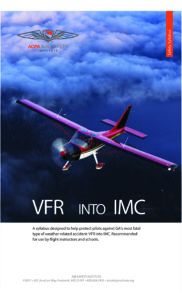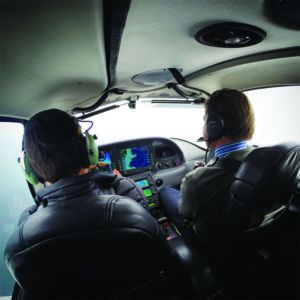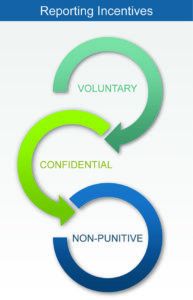Editor’s Note: NASA’s Aviation Safety Reporting System (ASRS) publishes a monthly newsletter, Callback, which highlights recent reports received by the organization. The newsletter can be of limited utility to typical general aviation operators, but not the December 2020 issue, which focused on GA pilots who inadvertently found themselves flying VFR into instrument conditions. These reports are instructive and we’re taking the liberty of publishing them here, as they appeared in Callback, with supplied commentary following each narrative.
STUDENT PILOT
“I was on a solo cross country. All forecasts showed overcast clouds at 6,000 feet. My route was 4,500 feet [outbound]…. [Enroute], I realized the clouds were not at 6,000 feet as forecast. I continued, as I was still under the cloud level. Just inland, I contacted Departure that I was descending down to 4,000 feet to continue VFR. As I descended, the clouds descended with me. Just a few miles [over] the land, I flew into a cloud accidentally, as the [cloud] layer was much lower. I then put the pitot heat and carb heat on and descended out of the cloud.
“At 2,500 feet, I came out of the cloud [and] noticed the visibility wasn’t much better and that the field might go IFR soon. [I] also noticed visible moisture on the windshield and texted my instructor that I had possible icing and that I was returning to [home base]. I then contacted Approach saying that I was [experiencing] possible icing. They then gave me straight…to the runway with no delay.
“Thankfully, I was first in line and didn’t need to declare an emergency. I flew straight toward [the airport],… landed safely, and taxied to [the ramp]. Once back, I showed my instructor the icing and discovered moderate mixed icing along all leading edges. I was able to stay calm and make a quick decision with…my instructor’s help…. This experience was very humbling, and the decision to go was probably wrong, but I trusted the forecast.”
Commentary: Realizing Plan A wasn’t going to work, the student called it quits, made a decision to divert back to the departure point and told ATC what was going on. One quibble is the decision to descend out of the bottom of the instrument conditions instead of performing a 180-degree turn back to known visual conditions. And it might be worthwhile for the student and instructor to review this flight’s planning. It would be rare that the possibilities of lowering ceilings and in-flight icing were not in the forecast.

According to the FAA’s Airplane Flying Handbook, “Accident statistics show that the pilot who has not been trained in attitude instrument flying, or one whose instrument skills have eroded, lose control of the airplane in about 10 minutes once forced to rely solely on instrument reference.” The guidance states there are three initial steps necessary for surviving an encounter with IMC by a VFR pilot:
Recognition/Acceptance
The pilot must accept the VFR-into-IMC event and that it constitutes a genuine emergency before an appropriate response can be made. But don’t panic; you can do this.
Maintaining Aircraft Control
The only way to control the airplane without outside visual references is to trust the flight instruments. Constantly searching outside for visual cues leads to spatial disorientation. The primary concern is keeping the wings level.
Obtaining available assistance
Once ATC is alerted and assisting, don’t overreact in an attempt to comply with their suggestions. Smoothly fly the airplane and don’t do anything that could worsen the situation.
Pictured at right, the AOPA Air Safety Institute has a valuable syllabus for instructors and schools to use in training pilots to respond to a VFR-into-IMC event.
VFR-ONLY PRIVATE PILOT
“I had checked the weather, and…it was clear below 6,500 feet…with the exception of the area right around JFK, which reported…multiple layers of clouds. No worries, I thought…. For some reason, I felt a huge pressure to make this flight. I wanted to see the mechanic scheduled to do our annual [inspection] in a few weeks…. Whatever the urgency, I soon would reverse my position on how important it really was. Shortly after departing ZZZ, I called for flight following and requested 4,500 feet…. The Controller, however, instructed me to turn direct to Kennedy (JFK) and climb to 6,500 feet. I should have simply replied ‘unable,’ as I know the weather was sketchy toward Kennedy, but for some unexplainable reason, I complied. Soon, I was struggling to maintain VMC…. The Controller was quite busy, and I was also quite busy trying to stay in legal conditions and control the aircraft.
“Then it all fell apart, and I was truly in unacceptable visual conditions. Trying not to panic, I used the autopilot to keep the plane under control and requested lower. ATC advised me I could not go lower and suggested I climb. I attempted to climb out of the poor visual conditions, but things only became worse. It seemed like quite a long time, probably 10 minutes, with truly inadequate visibility. Then the unthinkable happened; I became disoriented. I began to descend rapidly, airspeed increasing, and although I recognized what was happening, I could not correct the situation without adequate visual cues. It was a life changing event. It could happen to me after all! I had never come close to losing control of my aircraft before. I am usually very conservative…with my flight planning and in controlling ‘get-there-itis,’ and yet, here I was endangering myself and probably others. I was furious and ashamed of myself (and scared too). I came out of the clouds around 2,400 feet and brought the wings level and slowly pulled back. ATC admonished me, and I told him, ‘I became disoriented.’ He said, ‘Let’s try again,’ and directed me back to JFK, this time a little lower. I…was lucky enough to remain clear of clouds, and soon after, was granted lower still and proceeded direct to ZZZ1 without incident.
“I did some serious thinking after this flight on how I got myself into the situation in the first place, and how I should have avoided it. I knew that below 3,000 feet there was no problem with visibility…. I learned that ATC does not have a clear picture of visibility conditions…. Visibility is purely the pilot’s responsibility. I decided…to shake off complacency and went to my first FAA Safety Team (FAAST) meeting in years. It was totally worthwhile. I clearly did not understand how compromised visibility was…that afternoon until it was too late. I will never fail to call out ‘unable’ again.”
Commentary: Retelling this episode would be valuable if only because of the pilot’s wonderment at how the situation developed, the disbelief and the shame. That said, one lesson here is that the pilot is the final authority choosing the appropriate altitude, not ATC. And once again, we find that a timely 180 would have stopped the episode from developing. Finally, kudos to the pilot in volunteering for additional training in the form of a FAAST seminar.

Once we recognize and accept the situation, maintaining aircraft control is imperative. Depending on your altitude above terrain, initiating a climb may be an important next step. Additional altitude affords greater separation from obstacles plus improved radio and radar reception. You need to do the following nearly simultaneously:
• Attitude—Use the attitude indicator to level the wings.
• Heading—Maintain heading; turn only to avoid obstacles.
• Power—Adjust power as necessary for desired climb rate.
• Airspeed—Adjust airspeed as necessary.
The pilot must trust the flight instruments’ presentation of the aircraft’s attitude regardless of intuition or visual interpretation. Your inner ear’s motion sensing cannot detect the slight inertial changes necessary to maintain control and will be confusing.
COMMERCIAL/INSTRUMENT
“Conditions were VFR at ZZZ….We were returning after completing an uneventful VFR flight earlier in the afternoon…. Our destination was VFR. We were flying [my] friend’s PA-28 and had originally planned a VFR flight, departing around sunset and returning at night. However, there was [forecast] scattered light to moderate rain enroute, and since it appeared to be a relatively easy IFR flight at our planned 4,000 foot altitude, it seemed like an opportunity to give my VFR pilot friend some experience in IMC, as he is planning on starting his instrument training soon. He mentioned that he’s done quite a bit of hood time and felt comfortable flying his aircraft from the left seat. Reluctant at first, I agreed that he could be left seat, but I would be PIC. As the IFR rated pilot, I would do radio and navigation work. His…job was to keep a good course and altitude while I advised him. I could fly from the right [seat] if needed…. We talked…how the flight would go and then started the aircraft.
“Departure [from ZZZ] was VFR and uneventful. We were switched to Departure and given 6,000 feet direct JFK. We entered IMC during the climb. My friend at the controls was having some trouble reaching our target altitude and staying on heading…. At 6,000 feet,… my passenger pilot was having trouble keeping heading despite my instructions. We were off intended heading by as much as 40 degrees at times. Our altitude control was better, but we [were] off at least 200 feet at times, maybe more. It was clear that ATC was getting concerned with our situation. We corrected multiple times before ATC asked if we were having trouble and needed assistance. I only advised that we were correcting course, but after more deviations, the Controller asked if we [wanted priority handling]…. It was clear from the Controller that we were not performing well at all, so after an initial pause, I accepted [the priority handling]. When asked what I wanted to do, I suggested that we return to ZZZ. We were given vectors back and advised to expect a visual approach. The return was uneventful. We returned to the FBO to catch our breath and reassess the weather with the intent to return VFR when the rain cleared. An hour later or so, we departed on a northerly route around New York airspace and returned VFR uneventfully.
“Lessons – It was a huge mistake letting a VFR pilot fly left seat in IFR conditions and in an airplane I was unfamiliar with flying in [IMC] from the right seat. I was very unprepared to take over so soon after departure and fly his aircraft, let alone from the right seat….
“How the problem arose – Unexpected weather deterioration,… perceptions, judgments, and decisions….”
Commentary: An easy lesson to draw from this report is that instrument flying from the right seat is difficult if you’re not prepared for it. Another one is that returning to known good weather—there’s that 180-degree turn again—is a wise decision. Finally, don’t be afraid to use ATC as a resource.

The NASA ASRS has its roots in WWII aircraft accident investigations but wasn’t established in its current form until 1976. As the graphic at right highlights, ASRS participation is voluntary, confidential and not designed to punish anyone. In fact, timely submission of an ASRS report can be a “get out of jail free card” if the event you report comes to the FAA’s attention and the agency wants to initiate an enforcement case.
The organization takes in reports from a wide spectrum of aviation: pilots, air traffic controllers, cabin crew, dispatchers, maintenance technicians, ground personnel and others involved in aviation operations. Initially, some 400 reports per month were submitted but, according to ASRS, intake now averages over 2200 reports each week.
To learn more, visit asrs.arc.nasa.gov.
FLIGHT INSTRUCTOR
“Weather at the time of departure from ZZZ1: Visibility 6SM, Sky Condition OVC 011. TAF for destination at the time of arrival: Visibility 6SM, [Sky Condition] SCT 035.
“Before the flight, I reviewed the weather and determined the ceilings would be lifting enough to make a safe flight. I Departed ZZZ1 and remained in Class G airspace. I flew safely for one hour…remaining below cloud ceilings and remaining 500 feet from persons, vehicles, vessels, and structures. Approximately thirty minutes after passing ZZZ, the cloud ceiling lowered and fog moved in, reducing visibility to less than 1SM. I decided to make a precautionary landing in a plowed soybean field and landed safely with no damage to persons, aircraft, structures, or vehicles. I tied down the aircraft…and retrieved it three days later.
“…The safer decision would have been to wait a few days for the weather to pass. Another choice would have been to make a precautionary landing sooner on a runway at an established airport when the weather first began to collapse, instead of continuing flight in hopes it would improve.
“I believe the flight ended safely due to my comfortability, willingness, and experience with landing in a field as opposed to continuing flight into IMC.”
Commentary: An off-field precautionary landing is certainly an option, but so are the 180-degree turn and the climb, confess, comply trio discussed in the sidebar on the opposite page. That said, the reporter perhaps unconsciously highlights one of the ways pilots get into an inadvertent IMC encounter in the first place: continuing on in the hope conditions will improve.




